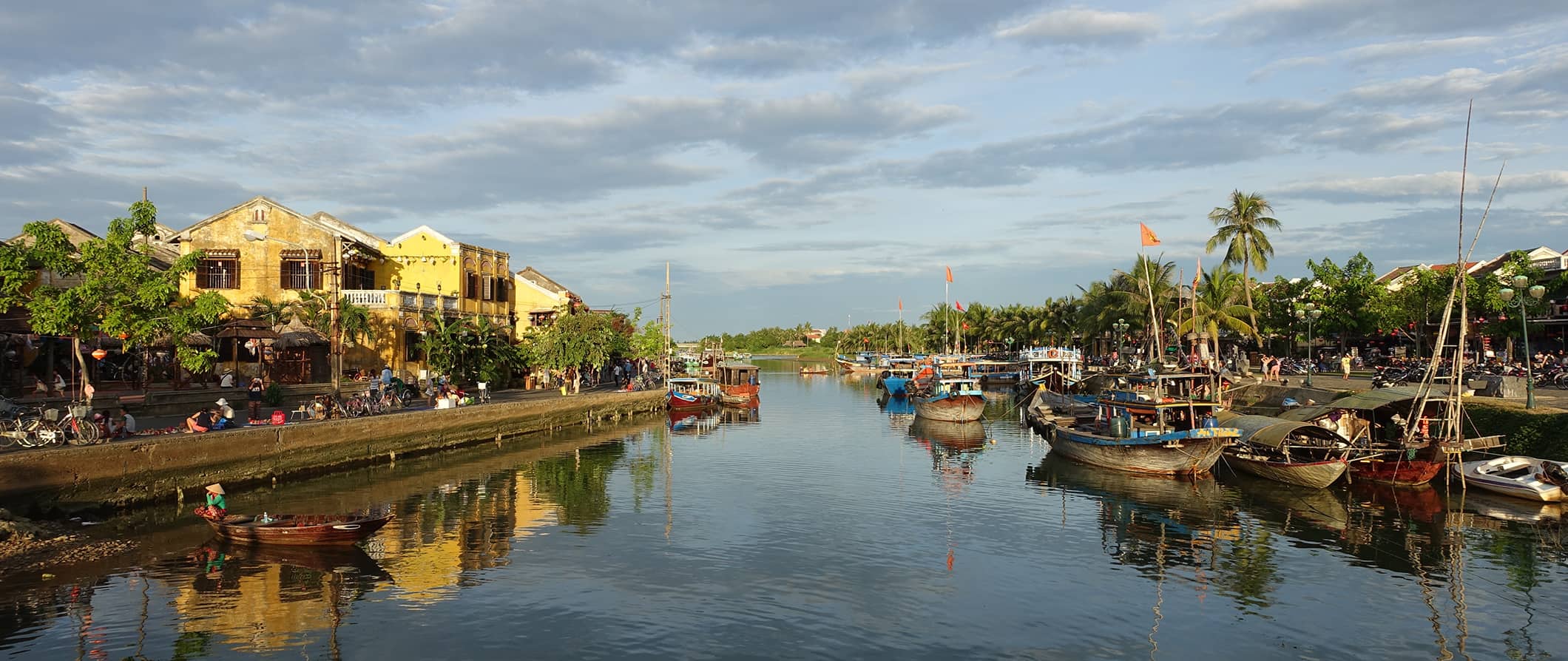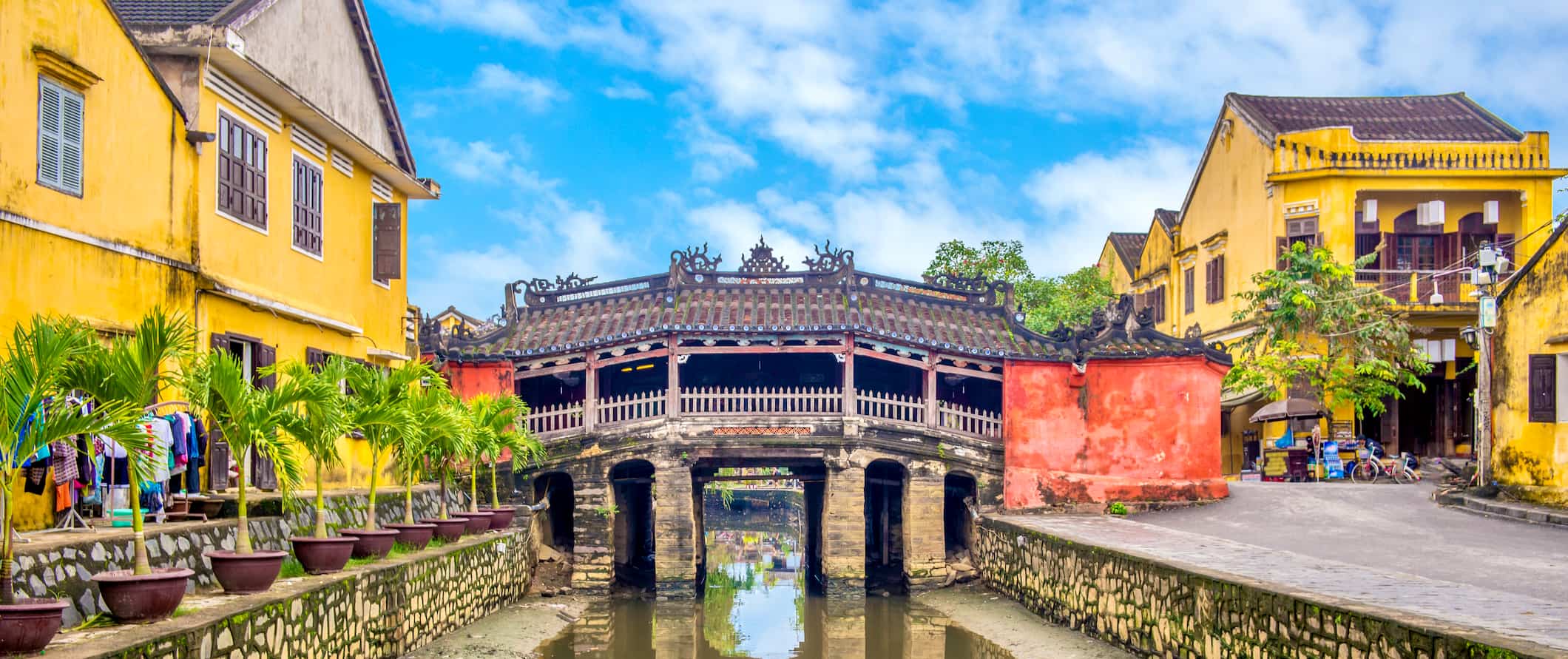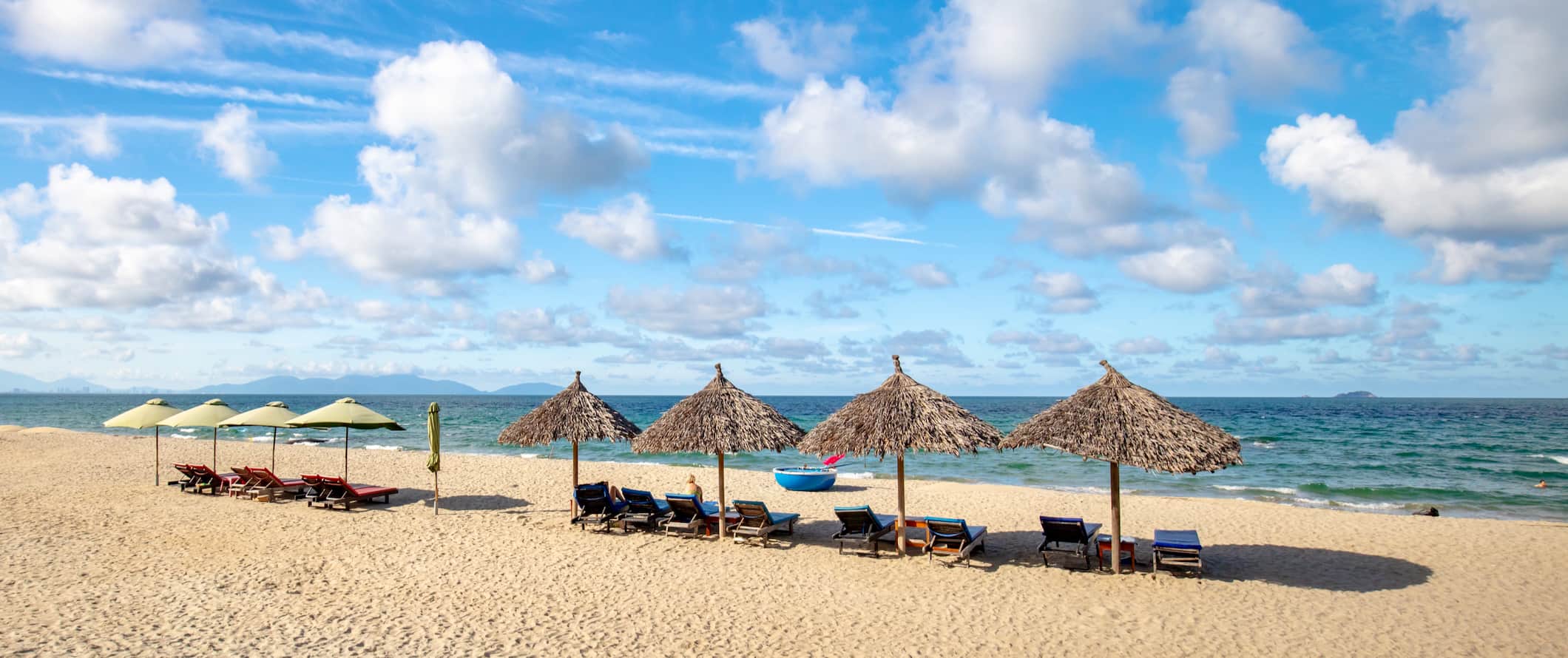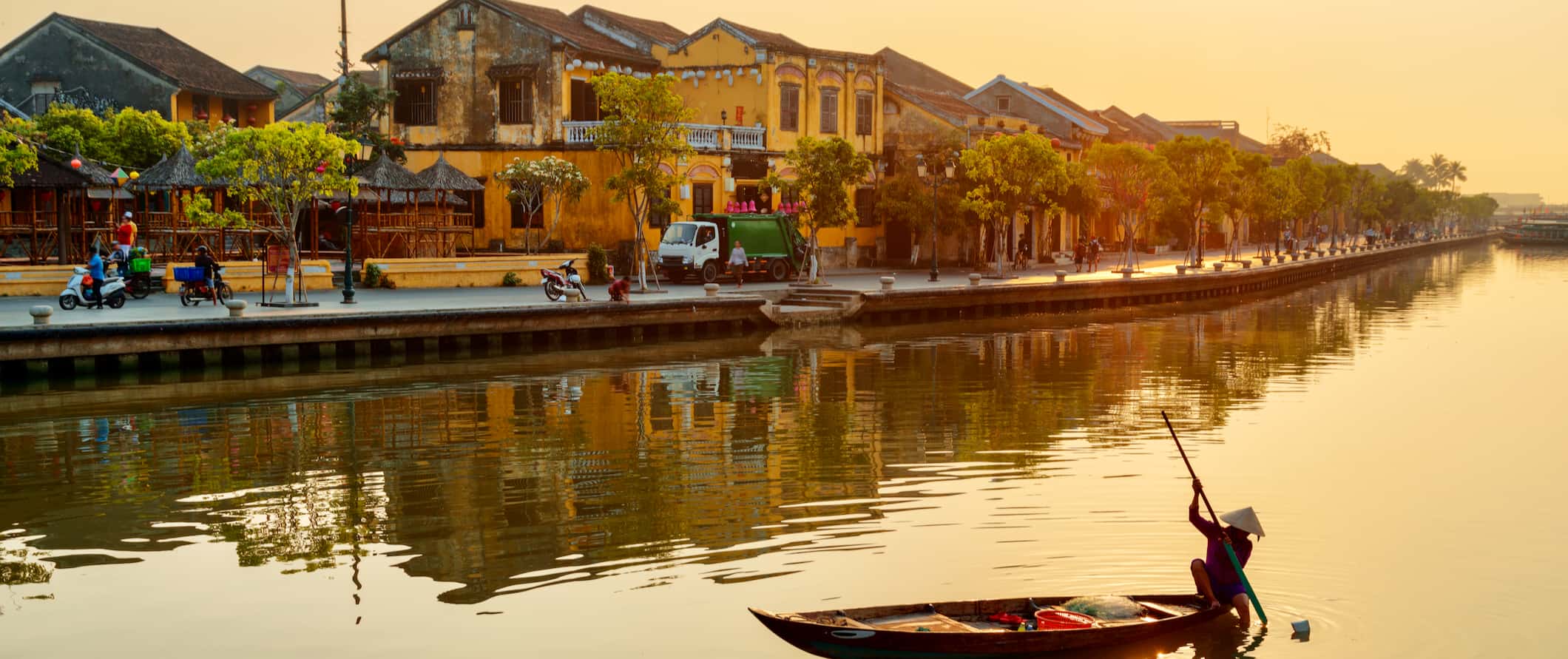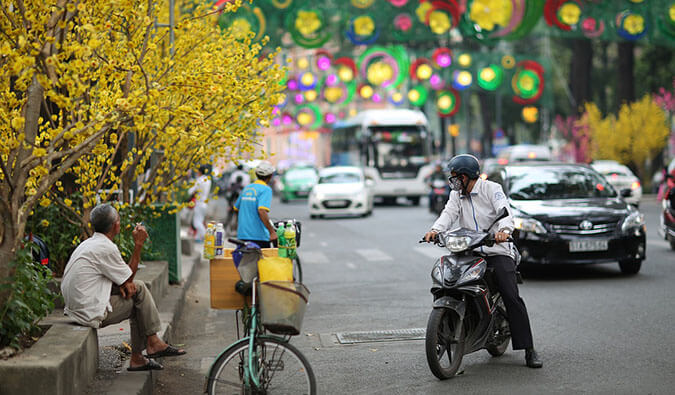Hoi An was my favorite destination in Vietnam.
When I backpacked Hoi An, I fell in love.
I loved spending time by the river, watching the sunset, strolling through the narrow streets of the Old Town strung with colorful lanterns, and drinking cheap beer. The city is packed with picturesque historical homes, pagodas, and street-side cafes.
It’s amazing.
Hoi An is an extremely popular place for buying handmade clothing and is one of the main reasons why people come here. The garment industry is the city’s main non-tourist industry. You can get anything made here, from custom-made suits to gowns to sundresses to leather boots to sneakers. The tailor shops will even mail all your goods home to you.
But, even if you don’t want to shop, Hoi An makes for a relaxing destination in an otherwise hectic country as the beach is only a 15-minute bike ride out of town.
This city was also my favorite place to gorge on Vietnamese food (don’t miss trying the cau lao that Hoi An is known for!).
Use this Hoi An travel guide to figure out how to make the most of your time in this amazing city. You definitely shouldn’t miss it.
Table of Contents
Top 5 Things to See and Do in Hoi An
1. Explore My Son
My Son is one of the most important sites relating to the ancient Kingdom of Champa and is said to have been Vietnam’s religious and intellectual center. Even in their ruined state, the remaining Hindu temple structures are impressive. Over 70 temples and tombs were constructed at the site between the 4th and 13th centuries by the former Kings of Champa in honor of the Hindu god Shiva. The temples are in a 2-kilometer (1.2-mile) wide valley surrounded by mountains, and the mouth of the sacred Thu Bon River flows past them. Excavation and restoration began in the 1930s and the area is now a UNESCO World Heritage Site. Admission is 150,000 VND per person. You can easily get to and from the site for less than 235,000 VND round-trip.
2. Relax on the beaches
An Bang and Cua Dai beaches are both close to Hoi An and are great places to spend an afternoon. Cua Dai is a 3-kilometer (2-mile) stretch of coastline that is part of the Hoi An Ancient Town UNESCO World Heritage Site and one of 8 UNESCO World Heritage sites in Vietnam. It provides a gorgeous retreat from the bustling streets of the city. North of Cua Dai, just 10 minutes outside of town, you’ll find An Bang. This laid-back beach and village attract artistic types and there are plenty of bars offering lively places to party. Both beaches offer soft white sand, bright blue water, and excellent beachside restaurants.
3. Take a cooking class
Many places in Hoi An offer lessons where you can learn to make tasty local dishes. You start off by picking the raw ingredients — such as sprouts, herbs, bamboo shoots, cucumber, and other fresh veggies — at a market. Then, you learn how to prepare the food. During your class, you get to prepare traditional dishes like spring rolls, banana flower salads, Pho, and Vietnamese pancakes. Prices vary, but most cost between 700,000-1,100,000 VND. The Hoi An Eco Cooking Class is the best option for lessons and classes.
4. Take a bicycle tour
On a guided tour around the city you’ll get to explore rice fields and see some of the neighborhoods that you wouldn’t normally venture through as a tourist. A morning of bicycling around in a small group starts at around 300,000 VND. Many of them are guided by local students who offer unique perspectives on the city. Tours usually last a few hours with stops at local businesses along the way. I recommend Heaven and Earth Bicycle Tours or Grasshopper Adventures.
5. Shop at the Central Market
Hoi An’s Central Market is one of the best in Vietnam. The market sits on the riverside and is packed full of excellent food at rock-bottom prices. If you’re looking to experience the flavors of Vietnam, this is the spot. Hoi An has always been a thriving center for trade and commerce and the market has origins in the 15th century when the city was part of the empire of Cham. The market gets going as early as 6am and quickly gets busy. If you want to beat the crowds, get there early. This is the place to pick up spices and souvenirs, try local food, and have your tailoring done.
Other Things to See and Do in Hoi An
1. Cross the Japanese Covered Bridge
This bridge is thought to have been built by Hoi An’s Japanese community in the late 16th century and roughly translated from Vietnamese, its name means “Pagoda in Japan.” NOTE: Nearly all of the attractions in the Hoi An Old Town are covered under the ticket price of 120,000 VND, including the bridge, the Old Houses, and the Museum of Folk Culture.
2. Visit Quan Cong Temple
The temple was built in the early 17th century to honor the Chin Dynasty, but nowadays it serves as one of Hoi An’s most spectacular architectural accomplishments. Inside there are two huge wooden statues, one of Quan Cong’s protector, Chau Xuong, and the other of his administrative official, Quan Binh. Of course, between them is the imposing statue of Quan Cong himself (also known as Zihuang), one of China’s most famous generals.
3. Experience Da Nang city
Located about 30 minutes from Hoi An, Da Nang is a bigger city famous for its Marble Mountains, sandy beaches, and active surfing scene. There is also an extravagant party scene here that is good for a night out once in a while. Most hostels can help groups of guests arrange transportation to and from Da Nang for the night.
4. Attend the Full Moon Festival
Hoi An’s Full Moon Festival is held on the 14th day of the lunar cycle each month and is probably the best time to visit the city if you don’t mind the crowds. The streets are shut down to all traffic and are lined with brightly colored lanterns. This is a fun time to party with locals as the streets come alive with folk music, plays, and dancing!
5. Take a trip to Cham Island
Cham Island lies just 21 kilometers (13 miles) from Hoi An in the South China Sea. The diverse marine life around Cham Island draws lots of divers, and because you’re in Vietnam, it’s very cheap to dive here (dives start from 000 VND). Most tours include lunch and free time on the beach, and it’s also possible to include a night dive in your excursion. If you are not into diving, a snorkeling tour costs around 1,060,000 VND.
6. See the Fujian Assembly Hall
Built in 1697, Fujian is the grandest of the Chinese assembly halls and is a first-rate example of Chinese architecture. The main colorful temple is dedicated to the goddess of the sea, Thien Hau, while the statues of Thuan Phong Nhi and Thien Ly Nhan are said to protect sailors in distress. There is a scale model of a sailboat inside too.
7. Visit the Museum of Folk Culture
This small museum aims to preserve the traditions and dress of rural Vietnamese culture. It is filled with plaster statues of figures in costumes that highlight life from here the past few centuries. There are almost 500 items in the collection and the museum is housed in a 150-year-old building. You can purchase a ticket that includes five sites of your choosing (including this museum) for 120,000 VND.
8. Head to the Marble Mountains
The Marble Mountains are a series of five mountains located 20 kilometers (12 miles) north of Hoi An. Besides the natural appeal, they also have many pagodas, and some also served as a base for Viet Cong fighters during the Vietnamese War. To get there, take the bus from Hoi An towards Nha Trang and get off at the Marble Mountains stop. It costs 40,000 VND to access the mountains.
9. Enter the Old Houses
Some of the houses in Hoi An have had their interiors turned into museums, giving tourists a glimpse at what life was like for wealthy merchants in the colonial and pre-colonial period. The Tan Ky and the Duc An homes are two of the more popular ones to visit and shouldn’t be missed if you’re a history buff.
Hoi An Travel Costs
Hostel prices – Hostel dorms with 10 or more beds go for about 117,000 VND per night while dorms with fewer beds cost 200,000-300,000 VND per night. Keep in mind that most of Hoi An’s main attractions are in the Old Town, so if you want to spend most of your time there, make sure your accommodation isn’t too far away. Private rooms start at about 352,112 VND for a double. Most hostels include free Wi-Fi, breakfast, and bicycle rentals.
Budget hotel prices – A night in a two-star budget hotel costs around 470,000 VND for a double room. A number of hotels have pools, and most have air-conditioning. Some even include free breakfast.
On Airbnb, you can find a private room for around 275,000 VND. Entire homes or apartments (some with swimming pools) are available starting from 470,000 VND per night.
Food – Vietnamese cuisine is fresh, flavorful, and uses a lot of herbs and vegetables. Rice and noodle dishes are common, as are various soups such as the iconic pho (a beef noodle soup). Wonton soup, meat curry, fresh French bread (known as banh me, and grilled fish are just some of the popular dishes you’ll encounter. Standard ingredients include fish sauce, lemongrass, chili, lime, Thai basil, and mint.
Street food starts at 15,000 VND per meal. Meals in restaurants start at about 30,000 VND and go up from there. You can get delicious banh mi at Bahn Mi Phuong for less than 46,440 VND. Wine is expensive so I would skip it (especially in restaurants).
Fast food (think burger and fries) costs around 120,000 VND for a combo meal. If you want to splash out, a nice meal at a mid-range restaurant costs around 175,000 VND.
Beer costs 20,000-30,000 VND. Coffee costs about 20,000-30,000 VND.
Food is so cheap here that I would not recommend cooking your food. Just grab street food, eat cheap, and you’ll save. It will cost you more in time and money to make your own meals.
Note: If you’re at the beach, restaurant owners will offer you a chair to sit on if you order food or drinks from them. You can relax in the sun while you wait for your pho, fruit platter, banh cuon, or fresh coconut to arrive.
Backpacking Hoi An Suggested Budgets
On a backpacker budget, you can visit Hoi An for 600,000 VND per day. This budget covers a stay in a hostel dorm, eating street food for all of your meals (pho and banh mi are very filling!), limiting your drinking, walking or cycling everywhere, and doing mostly free activities like enjoying the beach. If you plan on drinking, add another 20,000-40,000 VND to your daily budget.
A mid-range budget of about 1,125,000 VND per day covers staying in a cheap hotel, eating street food and at the occasional sit-down restaurant, enjoying a few more drinks, taking the occasional taxi to get around, and doing more paid activities such as museum visits and river tours.
On a “luxury” budget of 2,460,000 VND, you can stay in a nice hotel, eat out for all your meals anywhere you want, enjoy lots of drinks, and more taxis, and do whatever tours and activities you want. This is just the ground floor for luxury though. The sky is the limit!
Hoi An Travel Guide: Money-Saving Tips
Your dollar goes a long way in Hoi An (like it does in the rest of Vietnam)! That said, it never hurts to save even more money! Here are some ways to save in Hoi An:
- Camp on Cham Island – If you’re heading to Cham Island on a diving trip, it’s possible to save money on accommodation by camping on the beach.
- Shop around for handmade clothing – There are hundreds of tailors in Hoi An. If you’re having clothing made, check prices with a few places before settling on one. Asking a local to bring you to a tailor they trust is also a good suggestion.
- Skip the SIM Card – Hoi An is highly connected to Wi-Fi. You can access the Wi-Fi in just about every hotel, shop, restaurant, and convenience store for free!
- Eat at the market – Market stalls are some of the cheapest food you can find. Enjoy everything from Vietnamese donuts, banh mi, to soups and food with more substance — all for super cheap!
- Rent a bicycle – Bikes can be rented starting from 30,000 VND per day. This is a great way to leisurely explore the city.
- Drink in hostels – Lots of hostels have bars, cafes, restaurants, or something that acts as all three. Hostel owners know their audience, so they keep their prices down to keep people in their space. Win-win!
- Pack a reusable water bottle – The tap water here isn’t safe to drink so bring a reusable water bottle with a filter. It will save you money and thousands of plastic bottles. My preferred bottle is LifeStraw as it has a built-in filter to ensure your water is always clean and safe.
Where to Stay in Hoi An
Hoi An has some of the most affordable accommodation options in Vietnam. Here are some of my favorite places to stay in the city (if you want to be close to the Old Town make sure to check the distance from these hostels before booking):
How to Get Around Hoi An
Everywhere in central Hoi An is within walking distance, so it’s unlikely you’ll spend much on transportation here. The city is small (there are just 152,000 people here) and walking the Old Town is part of the experience.
Bicycle or Motorbike – If you choose to explore, you can rent a bicycle for about 30,000 VND or a motorbike for 165,000 VND per day. The Old Town is closed to motor traffic during certain hours of the day, but you’ll be able to take your bicycle in there. Many hostels/hotels have bicycle rentals available as well.
Cyclo – Cyclos (bicycle rickshaws) are common within the Old Town, and they make a leisurely way to get around. The cyclos can hold up to two people at a time and the drivers are super friendly and often keen to point out landmarks. You can negotiate a fixed hourly rate, or expect to pay about 22,000 VND per kilometer.
Taxi – The taxis are metered (and cheap) here. They start around 20,000 VND for the first kilometer and around 27,000 VND per kilometer after that. Grabbing a taxi from the airport to the center of the city should take about 30 minutes and costs about 200,000-330,000 VND. Don’t go in an unmetered taxi.
Car rental – You won’t need a car to get around Hoi An, and I wouldn’t recommend driving here as the roads are very hectic and the rules are almost never followed. Accidents are common so skip the car rental here.
When to Go to Hoi An
Hoi An is warm the whole year round, with an average daily temperature of 29°C (84°F). It rarely ever goes below 19°C (66°F) here. Unlike Northern Vietnam, Hoi An only has two seasons: rainy, and dry.
February through May is the best time to visit Hoi An thanks to pleasant daily temperatures and endless blue skies. If you want to hit the beaches (like Cua Dai and An Bang) this is also an excellent time to come.
June through August are the hottest months, with temperatures soaring as high as 38°C (100°F). Humidity can be high as well.
Hoi An’s rainy season lasts from September to January, with frequent heavy rain showers. These showers typically do not last long, but Hoi An has been prone to flooding in the past. Tourism traffic is also slowest during this time so expect lower prices.
If you want some excitement during your visit, plan your trip around the 14th day of the month’s lunar cycle. This is Hoi An’s Full Moon Festival and the city comes alive with music, dance, and celebrations.
How to Stay Safe in Hoi An
Hoi An is a very safe place to backpack and travel – even if you’re traveling solo or as a solo female traveler. Violent crime against travelers is infrequent, and petty crime isn’t a huge deal here either. In crowded places (especially the markets) you’ll want to keep your purse/wallet close and be mindful of the activity around you.
Be on the alert for scams. Most people are really just going to try to nickel and dime you and try to get you to spend extra money since they know, as a tourist, you have more than they do. Just keep an eye out.
If you’re worried about getting ripped off you can read about common travel scams to avoid here.
Solo female travelers should generally feel safe here, however, the standard precautions apply (never leave your drink unattended at the bar, never walk home alone intoxicated, etc.).
If you experience an emergency, dial 113 for assistance.
The most important piece of safety advice I can offer is to purchase suitable travel insurance. Travel insurance will protect you against illness, injury, theft, and cancellations. It’s comprehensive protection in case anything goes wrong. I never go on a trip without it as I’ve had to use it many times in the past. You can use the widget below to find the policy right for you:
Hoi An Travel Guide: The Best Booking Resources
These are my favorite companies to use when I travel. They consistently have the best deals, offer world-class customer service and great value, and overall, are better than their competitors. They are the companies I use the most and are always the starting point in my search for travel deals.
- Skyscanner – Skyscanner is my favorite flight search engine. They search small websites and budget airlines that larger search sites tend to miss. They are hands down the number one place to start.
- Hostelworld – This is the best hostel accommodation site out there with the largest inventory, best search interface, and widest availability.
- Agoda – Other than Hostelworld, Agoda is the best hotel accommodation site for Asia.
- Booking.com – The best all around booking site that constantly provides the cheapest and lowest rates. They have the widest selection of budget accommodation. In all my tests, they’ve always had the cheapest rates out of all the booking websites.
- Get Your Guide – Get Your Guide is a huge online marketplace for tours and excursions. They have tons of tour options available in cities all around the world, including everything from cooking classes, walking tours, street art lessons, and more!
- SafetyWing – Safety Wing offers convenient and affordable plans tailored to digital nomads and long-term travelers. They have cheap monthly plans, great customer service, and an easy-to-use claims process that makes it perfect for those on the road.
- LifeStraw – My go-to company for reusable water bottles with built-in filters so you can ensure your drinking water is always clean and safe.
- Unbound Merino – They make lightweight, durable, easy-to-clean travel clothing.
Hoi An Travel Guide: Related Articles
Want more info? Check out all the articles I’ve written on Vietnam travel and continue planning your trip:
